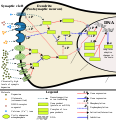File:ΔFosB.svg

Original file (SVG file, nominally 935 × 965 pixels, file size: 238 KB)
Captions
Captions
Summary
edit| DescriptionΔFosB.svg |
English: The finished, wikilink annotated version is currently located at en:Template:Psychostimulant addiction; a more detailed image caption is located there as well. For external (off-wiki) use, a screenshot of the annotated version is located at File:Annotated ΔFosB.svg screenshot.png. This image shows the signal transduction that occurs in nucleus accumbens D1-type medium spiny neurons that gives rise to psychostimulant addiction. This signaling cascade occurs during chronic high-dose use of certain dopaminergic stimulants (e.g., phenethylamine, methamphetamine, amphetamine, etc.). Cocaine induces a slightly different signaling cascade than the one shown here.
|
| Date | |
| Source | Own work |
| Author | Joseph Mickel (Seppi333) |
| Other versions | File:Annotated ΔFosB.svg screenshot.png - labeled version |
| Associated ΔFosB expression graph InfoField | File:ΔFosB accumulation.svg – shows how ΔFosB is induced following acute and repeated drug exposure and how it accumulates in neurons with repeated exposure to addictive drugs. |
| Presynaptic diagram InfoField | File:TAAR1 Dopamine.svg – illustrates the other side of the synaptic cleft for amphetamine and endogenous phenethylamine. |
Licensing
edit| This item is available under multiple licenses. When using it, you can choose which of the following licenses to use. Please make sure you respect the license terms of the license you choose, including any requirements and restrictions (such as attribution requirements and restrictions on commercial use). |
- You are free:
- to share – to copy, distribute and transmit the work
- to remix – to adapt the work
- Under the following conditions:
- attribution – You must give appropriate credit, provide a link to the license, and indicate if changes were made. You may do so in any reasonable manner, but not in any way that suggests the licensor endorses you or your use.
- You are free:
- to share – to copy, distribute and transmit the work
- to remix – to adapt the work
- Under the following conditions:
- attribution – You must give appropriate credit, provide a link to the license, and indicate if changes were made. You may do so in any reasonable manner, but not in any way that suggests the licensor endorses you or your use.
- share alike – If you remix, transform, or build upon the material, you must distribute your contributions under the same or compatible license as the original.
| Annotations InfoField | This image is annotated: View the annotations at Commons |
Top: ΔFosB
Bottom: JunD
This complex is the activator protein 1 transcription factor.
File history
Click on a date/time to view the file as it appeared at that time.
| Date/Time | Thumbnail | Dimensions | User | Comment | |
|---|---|---|---|---|---|
| current | 19:41, 9 November 2016 |  | 935 × 965 (238 KB) | Seppi333 (talk | contribs) | added 1 gene product box for AC in the cAMP pathway |
| 23:29, 21 July 2014 |  | 935 × 965 (238 KB) | Seppi333 (talk | contribs) | g protein color | |
| 23:15, 21 July 2014 |  | 935 × 965 (238 KB) | Seppi333 (talk | contribs) | changes to membrane structures | |
| 00:53, 21 July 2014 |  | 935 × 965 (223 KB) | Seppi333 (talk | contribs) | last recoloring | |
| 00:02, 21 July 2014 |  | 935 × 965 (228 KB) | Seppi333 (talk | contribs) | +1 upload | |
| 23:46, 20 July 2014 |  | 935 × 965 (228 KB) | Seppi333 (talk | contribs) | Reverted to version as of 04:45, 20 July 2014 | |
| 23:45, 20 July 2014 |  | 935 × 965 (229 KB) | Seppi333 (talk | contribs) | recolor | |
| 23:34, 20 July 2014 |  | 935 × 965 (228 KB) | Seppi333 (talk | contribs) | recolor | |
| 23:22, 20 July 2014 |  | 935 × 965 (228 KB) | Seppi333 (talk | contribs) | tweaks and color coding | |
| 04:45, 20 July 2014 |  | 935 × 965 (228 KB) | Seppi333 (talk | contribs) | wider boxes for sirt1/hdac1 again |
You cannot overwrite this file.
File usage on Commons
The following page uses this file:
File usage on other wikis
The following other wikis use this file:
- Usage on azb.wikipedia.org
- Usage on en.wikipedia.org
- Amphetamine
- Dextroamphetamine
- Adderall
- Protein c-Fos
- Methamphetamine
- FOSB
- Addiction
- Behavioral epigenetics
- User:Seppi333/sandbox
- Template talk:Annotated image 4
- User talk:Boghog/Archive 8
- Wikipedia talk:WikiProject Molecular Biology/Molecular and Cell Biology/Archive 5
- Wikipedia talk:WikiProject Medicine/Archive 51
- Template:Psychostimulant addiction
- Wikipedia:Featured picture candidates/August-2014
- Wikipedia:Featured picture candidates/ΔFosB
- User:IDidThisForSchool/sandbox
- Talk:MDMA/Archive 5
- Template talk:Addiction glossary
- Wikipedia talk:WikiProject Pharmacology/Archive 8
- Wikipedia talk:Image use policy/Archive 15
- Template:Annotated image 4/transclusions
- User talk:Seppi333/Archive 1
- Talk:Alcoholism/Archive 8
- User:Gallina x/Gather lists/19635 – History of IDEAS
- User:Gallina x/Gather lists/25316 – Madonna
- User:Gallina x/Gather lists/26649 – Female feelings: "To die for" thesis
- User:Gallina x/Gather lists
- User talk:Seppi333/Archive 2
- User:It's gonna be awesome/amphetamines-related
- User:WikiLinuz/Pharmacology and neuroscience
- Usage on pt.wikipedia.org
- Usage on zh.wikipedia.org
Metadata
This file contains additional information such as Exif metadata which may have been added by the digital camera, scanner, or software program used to create or digitize it. If the file has been modified from its original state, some details such as the timestamp may not fully reflect those of the original file. The timestamp is only as accurate as the clock in the camera, and it may be completely wrong.
| Width | 935 |
|---|---|
| Height | 965 |